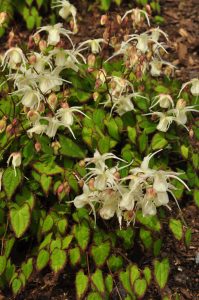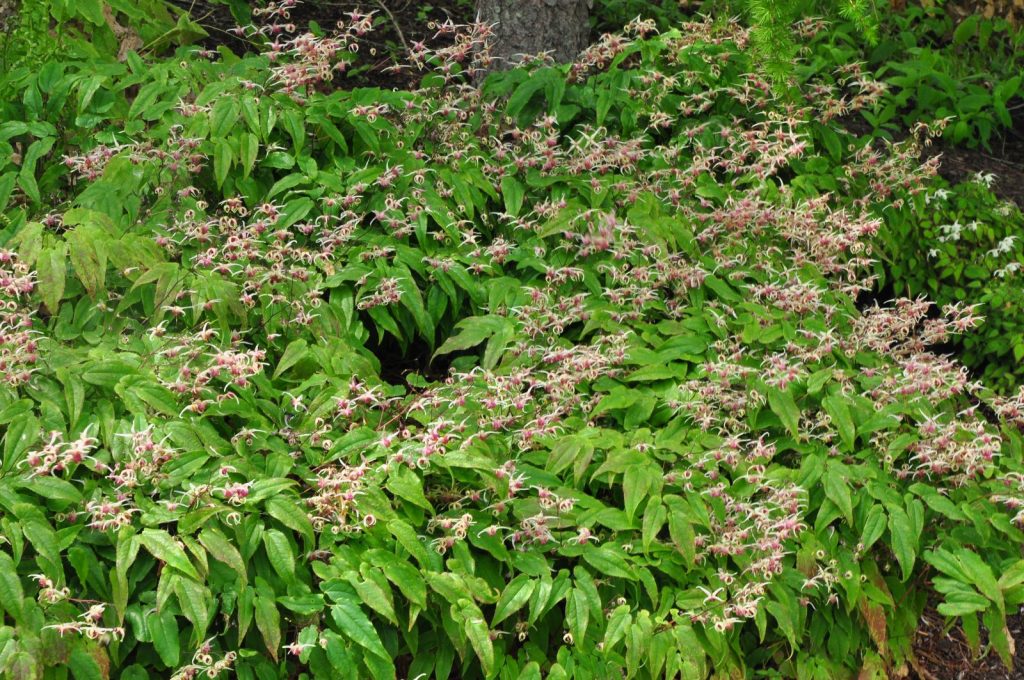At CMBG, Epimedium is an important genus. In 2023, we developed two new collections plans to guide the creation and expansion of our priority plant collections. One of these plans focuses on the genus Epimedium. Creating a collection plan is a collaboration between the Plant Science & Horticulture departments and requires a deep dive into the genus, including researching the history, taxonomy, distribution, ecology, morphology and human uses of Epimedium.
Epimedium at the Gardens—Expanding our Plant Collections
After finishing this background work, we decided to shape our collection around human relationships with Epimedium as an ornamental plant. Our aim is to continue building a collection that highlights the diversity and utility of Epimedium as a group of ornamental plants well-suited to a northern coastal climate, and to showcase a genus of exemplary horticultural value for our visitors to enjoy.
Epimedium has a long history of human use as an ornamental plant, and is an ideal genus for ornamental use because it has a wide diversity of traits. Species within the genus can be evergreen or deciduous; clump forming or rhizomotously spreading; exhibit purple, bronze, green, or speckled new growth; and display a wide variety of flower forms and colors. This diversity of traits has made Epimedium ideal for a range of garden uses. Additionally, Epimedium is a resilient genus, with few pest problems, a tolerance for dry conditions, and a preference for shade. This ease of growing has made Epimedium a popular ornamental plant for both professionals and home gardeners.
Epimedium can hybridize readily both in the wild and in cultivation wherever multiple species are growing in close proximity and bees are present. Bumblebees (Bombus species) are the primary pollinators, though smaller bees in the genus Eucera have also been observed pollinating Epimedium. This ability to hybridize easily has allowed for the introduction of a wide range of cultivars into the horticultural trade, which has added to the popularity of Epimedium as an ornamental plant.


Currently, we have 38 species and cultivars in our collection and plan to keep adding more. To highlight diversity, we display Epimedium species that are representative of the taxonomic subdivisions within the genus, including the two subgenera, four sections and four series within the genus Epimedium. In addition to these representative species, we also display species that are common parents of cultivars. In order to highlight the horticultural value of Epimedium, we display both cultivars that are unique and unusual, and those that are commonly found for sale at nurseries. Our mission is to create connections between people and plants, and the Epimedium collection at CMBG brings guests into contact with plants they can successfully incorporate into their home gardens, hopefully creating a meaningful connection between plants and people.
Epimedium are currently blooming at CMBG! Find them in the Lerner Garden of the Five Senses, the Reiser Woodland Garden and the Giles Rhododendron Garden. Some of our favorites are Epimedium stellatum, Epimedium ‘Domino’, Epimedium × warleyense ‘Orangekönigin’, Epimedium grandiflorum ‘Circe’ and Epimedium grandiflorum var. higoense ‘Bandit’!

Katherine Brewer is the Curator of Living Collections and works in the Plant Science & Collections Department at the Gardens.

